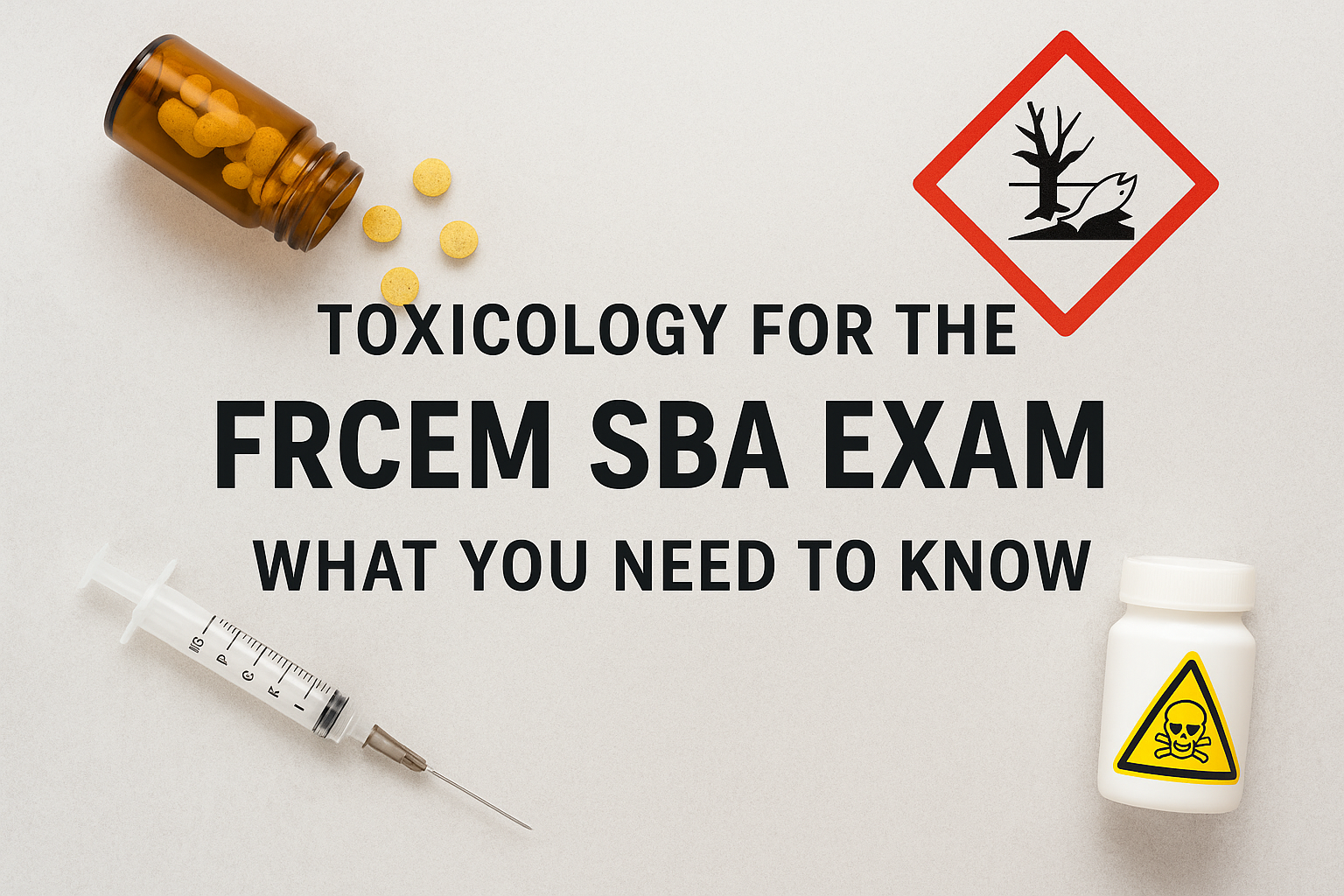1. Introduction
Toxicology is a vital, high-yield topic for the FRCEM Single Best Answer (SBA) exam. Emergencies involving poisoning and overdose are common in UK emergency departments, and the RCEM curriculum reflects this. Whether you're facing a question on paracetamol overdose or the subtle signs of serotonin syndrome, being prepared in this area can significantly boost your score. In this guide, we’ll walk you through the essential knowledge, common exam pitfalls, and effective strategies for tackling toxicology SBAs with confidence.
2. The Weight of Toxicology in the FRCEM SBA Exam
Toxicology typically accounts for around 5% of SBA questions. It falls under the 'Toxicological Emergencies' and 'Major and Catastrophic Incidents' domains in the RCEM curriculum. Expect scenarios that test your ability to interpret ECGs, manage common overdoses, and understand the pharmacological basis of treatment decisions.
Key exam scenarios include:
- Acute and staggered paracetamol overdoses
- ECG changes in tricyclic antidepressant overdose
- Recognition of toxidromes (e.g. cholinergic, anticholinergic)
- Management of beta-blocker or calcium channel blocker toxicity
3. Core Topics You Must Know
3.1 Paracetamol Overdose
- Most commonly tested overdose
- Differentiate between single acute overdose and staggered ingestion
- Use of the Rumack-Matthew nomogram (not for staggered)
- Indications and duration of NAC (N-acetylcysteine)
- Monitor LFTs, INR
3.2 Salicylate Poisoning
- Classic presentation: tinnitus, tachypnoea, nausea
- Mixed respiratory alkalosis + metabolic acidosis
- Severity determined by serum level and clinical status
- Dialysis indications: severe acidosis, renal failure, very high levels
3.3 Tricyclic Antidepressants (TCA)
- Common features: drowsiness, seizures, arrhythmias
- ECG findings: prolonged QRS (>100ms), right axis deviation
- Treat with IV sodium bicarbonate
3.4 Beta-blockers and Calcium Channel Blockers
- Bradycardia, hypotension, shock
- First-line: atropine, IV fluids
- Second-line: glucagon, high-dose insulin euglycaemia therapy (HIE)
- Calcium gluconate for CCB overdose
3.5 Opiates
- Pinpoint pupils, respiratory depression, low GCS
- Naloxone titration: 100–400 mcg IV, repeat as needed
- Beware of re-sedation due to short half-life of naloxone
3.6 Serotonin Syndrome vs Neuroleptic Malignant Syndrome
- Serotonin: clonus, hyperreflexia, agitation
- NMS: rigidity, hyperthermia, elevated CK
- Treat serotonin syndrome with benzodiazepines and supportive care
- Treat NMS with dantrolene or bromocriptine
3.7 Alcohol and Toxic Alcohols
- Ethanol: CNS depression, hypoglycaemia
- Methanol/ethylene glycol: raised anion gap metabolic acidosis, visual symptoms (methanol), renal failure (EG)
- Antidotes: fomepizole or ethanol; dialysis in severe cases
3.8 Carbon Monoxide and Cyanide
- CO: headache, confusion, cherry red lips (rare), high COHb on ABG
- Treat with 100% oxygen, consider hyperbaric oxygen
- Cyanide: rapid collapse, lactic acidosis
- Treat with hydroxocobalamin
4. High-Yield Pearls and Exam Tricks
- ECG findings often hold the key: always assess QRS duration, QT interval
- Metabolic acidosis + high anion gap = look for salicylates, methanol, EG
- Know your toxidromes: they guide antidote use
- Use lab clues: paracetamol level, osmolal gap, ABG findings
5. Practice Question Walkthrough
Question:
A 28-year-old woman presents 2 hours after ingesting 20g of paracetamol. She is asymptomatic. Her paracetamol level at 4 hours is 180 mg/L. What is the most appropriate next step?
A. Discharge with safety netting
B. Start NAC immediately
C. Wait for LFTs and INR
D. Repeat paracetamol level in 2 hours
E. Administer activated charcoal only
Answer: B. Start NAC immediately
Rationale: Her level is above the treatment line at 4 hours. NAC is indicated.
6. Resources for Revision
- RCEMLearning Toxicology Modules – curriculum-aligned
- TOXBASE – gold standard UK poisons database
- Oxford Handbook of Emergency Medicine – concise toxicology summaries
7. Final Tips Before the Exam
- Focus on red flags and antidote indications
- Practice ECG interpretation under time pressure
- Use TOXBASE and the BNF for last-minute reinforcement
- If stuck in the exam, eliminate distractors and look for the physiological basis of the answer
8. Conclusion
Toxicology questions are among the most clinically relevant and rewarding to master for the FRCEM SBA. By focusing on key patterns, management steps, and toxidrome recognition, you'll be well-prepared. Keep reviewing the common overdoses, and don’t forget to practice with realistic SBAs.






